 There are so many places to see birds in South America, covering a wide variety of habitats and ecosystems. In the second part of our blog about our experiences of birding in South America, I will talk a bit about some of the places we visited. To make it a bit more cohesive, I have roughly grouped them into seven themes, each with its own accompanying gallery of some of our favourite photos.
There are so many places to see birds in South America, covering a wide variety of habitats and ecosystems. In the second part of our blog about our experiences of birding in South America, I will talk a bit about some of the places we visited. To make it a bit more cohesive, I have roughly grouped them into seven themes, each with its own accompanying gallery of some of our favourite photos.
Bruce here again…

A Slate-coloured Hawk peeks over the foliage
The thing about taking photographs of birds is that it is very difficult! Becca spent a lot of time trying to take photos with her non-specialist equipment, chosen to be practical and versatile for long-term travel rather than for wildlife photography (for the most part she used a Panasonic Lumix DMC-FZ200, without a large zoom lens that professionals use). This meant that a lot of the photos she took were really only useful as an aide-memoire because the digital zoom is only so good (some of these grainy shots we’ve included here anyway, as a record). There were also lots of photos of a branch with no bird on as it took off just as she pressed the shutter. Adding to the difficulties is the unwritten rule of nature that whenever Becca gets her camera out, animals turn their backs and present arse!

This Andean Pygmy Owl could see us clearly
Circumstances are not always perfect either – sometimes we were bobbing in a boat trying to hold a camera with fully extended zoom lens steady, and often the light was poor, in the trees or at dusk. Birds also have a tendency to hide in the foliage and, by definition, when when they are above you the only angle for a shot may not be the most flattering!

Not a very flattering angle of a Mealy Amazon

Sometimes you take pictures for the memories, not necessarily for show, such as this endemic Plate-billed Mountain-toucan
Where we went
Penguins, Patagonia and beyond

A pair of King Penguins
Something that Patagonia is not short of is penguins. The two most common are Magellanic in Argentina and Humboldt in Chile, a couple of species that are quite similar and like to nest under bushes in the desert heat. It is best to go in the breeding season to see them in large numbers (by the tens of thousands in Punta Tombo, Argentina) and the contrast of them with Lesser Rheas and Guanacos (wild Llamas) was striking. We nearly missed out going to Puerto Deseado, where we took a boat trip out to an island to see Rockhoppers, whilst just south of Porvenir in Chile there is a small colony of King Penguins on the mainland. The gallery has pictures of all seven species that we saw, including off the coast of Peru and the Galapagos.

Are you my partner? A pair of Magellanic Penguins greet each other as one returns from the sea with food

It can get quite hot in the desert that is eastern Patagonia

The colonies can be quite big and spread out

Many nests are just hollows at the base of a bush
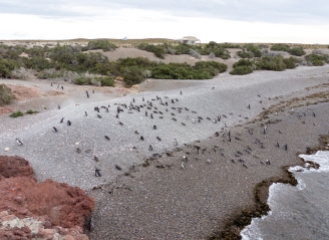
Penguins going fishing. One of the pair fishes, whilst the other looks after the chicks

The colonies are well managed by the park authorities and penguins always have the right of way…

But they do have to share with Guanacos

Becca taking time to appreciate the Rockhopper Penguins in Argentina

Rockhopper by name, rockhopper by nature…

Still hopping…

A Gentoo

The most common penguin we saw in Antarctica was the Gentoo

A penguin highway to and from the sea through the snow

They are much more graceful in the water

We watched this Gentoo try and defend her chick from these two skuas…

…but after a long battle she failed

An Adélie Penguin in Antarctica

Penguins often eat krill, which is pink, so everything becomes pink after a while. You can also smell a penguin colony from miles away

These are male Chinstrap Penguins. They don’t breed in the Antarctic itself

A colony of King Penguins in Tierra del Fuego

Humboldt Penguins off the coast of Peru are very similar to the Magellanic Penguins

A pair of Galapagos Penguins
The Atlantic coast and Antarctica
This small gallery starts with some birds from the Atlantic coast of Patagonia and then works around the coast south to Tierra del Fuego, from where we took a boat down to Antarctica. Many of the pictures from both the coast and Antarctica are of penguins and so are in the previous gallery!

Flying Steamer-duck off the coast of Argentina. This is related to a species in Tierra del Fuego that doesn’t fly

A Chimango Caracara feeding off a Magellanic Penguin carcass

Some sort of Flycatcher (?) in Patagonia. This is where local birding guides are helpful!

One of my favourites, a Red-legged Cormorant

Imperial Cormorants off the Atlantic coast of Argentina

Snowy Sheathbills scavenge food from the faeces of pelicans and sealions!

A pair of slightly demonic looking Blackish Oystercatchers

A pair of Imperial Cormorants

Antarctic Terns
The Pacific coast from Chile to Ecuador

Where desert meets sea
There is only really one word for this region – seabirds! The Humboldt Current is a body of cold water that that flows from the southern tip of Chile to northern Peru and is incredibly rich in nutrients. The current can support a huge quantity of krill and fish, which in turn support large numbers of seabirds. As well as the beautiful Inca Tern, seeing large flocks of Brown Pelicans and hundreds of Frigatebirds circling are sights that have to be seen to be believed. I have never seen so many cormorants and gannets as on a speedboat trip around Las Islas Ballestas, from Paracas in Peru.

Guanay Cormorants lined up on an island
This gallery works around the coast south to north on the western side of the continent, starting with a side trip to Robinson Crusoe Island.

The Juan Fernández Firecrown is endemic to Robinson Crusoe Island and is, I believe, the only hummingbird species where the males (red) are a completely different colour to the females

A sight we always appreciated – a group of pelicans flying by, often at dusk

A Chimango Caracara on the coast of Chile

Peruvian Boobys and Pelicans resting off the coast of Chile

Nootropic Cormorants are very common – here with Valparaiso in the background

Peruvian Pelicans are found all along the coast

This sea arch off the coast of Antofagasta, Chile, doesn’t have a dark rocky surface…

…it is covered with seabirds

The cold Humboldt current is one of the richest in the world and can support huge numbers of seabirds

Flamingos on the shoreline of Southern Peru near Paracas

Pelican, Skimmer and a Long-billed Curlew (?)

The White-winged Dove ranges throughout Central America and the Caribbean but there is an enclave along the Peruvian coast

Thick flocks of cormorants

Inca Terns sharing with a sealion

The distinctive Inca Tern

The Humboldt current means that there are plenty of fish for both humans and seabirds

Trying to work out which terns are down there…

Peruvian Boobys feed by spectacular dives straight into the sea

The harsh desert of the Peruvian coast is punctuated by delightful green and fertile valleys

A Peruvian Thick-knee

We came across a number of Burrowing Owls. This one was guarding an ancient tomb on the coast of northern Peru

Not far from the most westerly point in South America

Pelicans at sunset in northern Peru

We spent awhile watching this female Scarlet-backed Woodpecker in a dry forest on the coast of northern Peru…

…she likes to hang upside down
The Andes

Chilean Flamingos dancing, which is how they display during the breeding season. The lake here is at about 4,600m altitude and freezes overnight, freezing the flamingos in place
The Andes span from Tierra Fuego in the south, where they are barely 1,000m tall, to Colombia in the north, via the Altiplano in Boliva at 4,000m. This is where you go to see the Andean Condor and after our first distant sightings in the far south, it was only really when we were buzzed by one whilst climbing in Frey, Argentina, and watching five adults and four juveniles feeding on a carcass behind us in the Colca Canyon, Peru that we truly appreciated the size of these birds. Of course, the salt pans of the Altiplano are great places to see three of the four species of flamingo that can be found in South America.

We were lucky to see this male Magellanic Woodpecker down in Tierra del Fuego where the Andes begin

Black-necked Swans in the Chilean fjords in the south of Patagonia
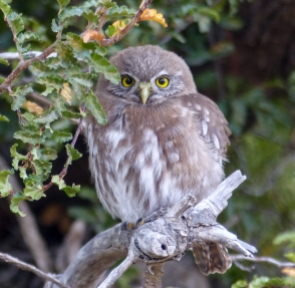
We spent a long time enjoying this Austral Pygmy Owl in a campsite in the Torres del Paine, Chile

Our first Andean Condor sighting at Torres del Paine

This Chucao Tapaculo we came cross in Chile was very bold

Chilean Flamingo near San Pedro de Atacama, Chile

A second species of flamingo at San Pedro – an Andean Flamingo

Andean Avocet

Puna Plover, San Pedro de Atacama

Puna Teal on the Altiplano, Bolivia

A pair of Andean Geese putting up with a cold wind

Puna Teals are quite widespread throughout the Altiplano

Yellow-billed Pintails are easily recognised by their yellow bill and are found throughout the Andes

Giant Coots are actually very big!

Red-backed Sierra-finch

There are lots of flamingos in southern Bolivia along the high altitude ‘lagoon route’

James’s Flamingo, one of three species here
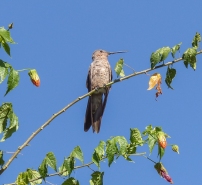
This White-bellied Hummingbird was a resident at our hostal in Sucre, Bolivia…

…there were plenty of flowers for it to feed on

We came across this Mountain Caracara…

…and its nest in northern Bolivia

American Kestrels are quite common

The Andean Lapwing takes over from the Southern Lapwing in the Andes

Flamingos and Vicuña (related to Guanacos)

Andean Woodpeckers nest in holes in the ruins of Tiwanaku, Bolivia

A Black-throated Flowerpiercer feeds by piecing the base of flowers to get at the nectar

A pair of juvenile Andean Condors at the Mirador del Condor, Colca Canyon, Peru

It’s not often you see so many flying at the same time…

…but there was a carcass that they were feeding on (three adults and three juveniles here)
Cloud Forests
 There are few environments that can beat cloud (or fog) forests for the sheer biodiversity of birds. They are found at altitudes around 500m – 3,000m in the Andes, generally in a tight band dependent on the local environmental conditions. The only problem is that they are also good places to find mosquitoes and black flies, whilst the foliage provides perfect camouflage for the birds. In fact the first place we went in northern Argentina (Parque Nacional Calilegua) was where we discovered the those downsides.
There are few environments that can beat cloud (or fog) forests for the sheer biodiversity of birds. They are found at altitudes around 500m – 3,000m in the Andes, generally in a tight band dependent on the local environmental conditions. The only problem is that they are also good places to find mosquitoes and black flies, whilst the foliage provides perfect camouflage for the birds. In fact the first place we went in northern Argentina (Parque Nacional Calilegua) was where we discovered the those downsides.

A Red-headed Barbet in Mindo, Ecuador
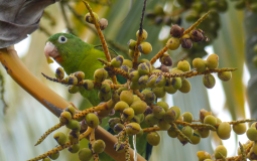
A Mealy Amazon hides behind its food…

A Cock-of-the-rock at a lek, Mindo, Ecuador
We visited a couple of places (Mindo, Ecuador and Minca, Colombia) where we hired excellent local guides to help us. Mindo also has a plethora of hummingbird feeders and a couple of known Cock-of-the-rock leks (where lots of males get together and compete for females). The noise of these leks is something to experience. I have also included a few birds from non-cloud forests in the following gallery.

Female White-fronted Woodpecker, northern Argentina

Plush-crested Jay in northern Argentina

We heard these Scarlet-fronted (?) Parakeets long before we spotted them occupying this tree

Birding in Mindo, Ecuador

Our guide was excellent and could pick up a bird in the scope within seconds of spotting it

Sickle-winged Guan

Flame-faced Tanager
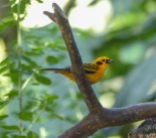
Golden Tanager

Purple-throated Euphonia

Blue-necked Tanager

Rufous Motmot

A pair of Male Cock-of-the-rocks at an early morning lek

Andean Emerald

An Andean Emerald…

…and a White-necked Jacobin…

…together on a feeder

However, Hummingbird feeders can lead to conflict

Male Masked Trogon

Female Masked Trogon

Turquoise Jay

Blue-winged Mountain-Tanager

Male Masked Trogon

Fawn-breasted Brilliant

Green Violetear

Masked Flowerpiercer

A Male Booted Racket-tail…

…and a female Booted Racket-tail has not racket-tail!

Blue-winged Mountain-Tanager

Sparkling Violetear

We saw Vermillion Flycatchers in several countries but it took us a while to see a male one like this

White-vented Plumeleteer
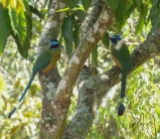
We spied this pair of Amazonian Motmots quite unexpectedly in the distance to the side of the road when we pulled off for a break one morning

Spot the hummingbird…

Blue-grey Tanagers are very common in Colombia

Palm Tanager
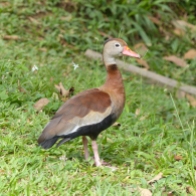
Black-bellied Whistling-Duck

Orange-fronted Yellow-Finch

Again, spot the hummingbird…

Blue-headed Parrots

There were lots of pairs of Acorn Woodpecker at a coffee plantation near Salento, Colombia…

…along with a breeding pair of Crimson-rumped Toucanets

A Yellow-backed Oriole (and a Blue-gray Tanager?)

Male Summer Tanager

Male Long-tailed Sylph

This juvenile Santa Marta Woodstar is endemic to a very small area round Santa Marta, northern Colombia

These Rufous-tailed Hummingbirds seem to do well with the feeders and we saw them from Ecuador to the north of Colombia

The Christmas decorations were proving a little confusing for the hummingbirds used to hanging feeders in December in Minca

The Keel-billed Toucan’s range only just extends south into Colombia

Squirrel Cuckoo – we saw a few but only managed one good photo!

Female Black-backed Antshrike, Minca, Colombia
Pantanal vs The Amazon

The distinctly odd looking Spoonbill, in the Pantanal
There is a saying that if you want to see jungle, go to the Amazon; if you want to see animals, go to the Pantanal. Most people know about the Amazon but fewer know of the vast wetlands in Brazil/Bolivia that is known as the Pantanal. What these two area have in common is that they flood for half the year, whilst the Pantanal dries up for the other six months.

A Capped Heron fishing in the Pantanal
 The Pantanal is perfect for seeing wildlife because there is much less vegetation and when it is dry, the animals crowd round the available water sources (perfect for seeing Jaguars), whilst when it is wet, many animals are confined to the islands. We had a fantastic time driving in and out the Pantanal across many bridges (128 in 130km in the northern Pantanal). It is possible to see lots of wildlife from each one so you need to take your time driving around here! Lots of storks, herons and raptors to be seen, along with the beautiful Hyacinth Macaw and the Blue-and-yellow Macaw. We did manage to see birds in the Amazon, whilst on a great conservation cruise in the Pacaya-Samiria Reserve, Peru, but it was much more difficult to spot them and they were even harder to photograph. This is the largest of the galleries!
The Pantanal is perfect for seeing wildlife because there is much less vegetation and when it is dry, the animals crowd round the available water sources (perfect for seeing Jaguars), whilst when it is wet, many animals are confined to the islands. We had a fantastic time driving in and out the Pantanal across many bridges (128 in 130km in the northern Pantanal). It is possible to see lots of wildlife from each one so you need to take your time driving around here! Lots of storks, herons and raptors to be seen, along with the beautiful Hyacinth Macaw and the Blue-and-yellow Macaw. We did manage to see birds in the Amazon, whilst on a great conservation cruise in the Pacaya-Samiria Reserve, Peru, but it was much more difficult to spot them and they were even harder to photograph. This is the largest of the galleries!

Great Kiskadees are everywhere

A Wood Stork

Black-crowned Night-Heron – at night!

Forked-tailed Flycatcher

The Southern Caracara has a very wide distribution

Neotropical Cormorants are common and widespread
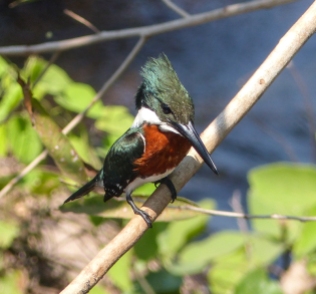
Male Amazon Kingfisher

Ringed Kingfisher

Female Amazon Kingfisher

Rufous-tailed Jacamars

Great Egret

White-faced Whistling Ducks

Limpkin

Male White Woodpecker

A pair of Green-barred Woodpeckers. The male has the red cheek

Red-crested Cardinal

Orange-backed Troupial
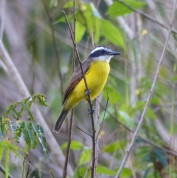
Kiskadees, both Great and Lesser, are widespread. The Great Kiskadee has a very distinct call that can be heard throughout northern South America

Female Lineated Woodpecker

A Black-collared Hawk

Chaco Chachalacas can be heard every where in the Pantanal and have a very distinctive call that gives them their name

We saw a few Bare-faced Currasows in the Pantanal

White-throated Piping-guan

A Faciated Tiger-Heron?

Rufescent Tiger-Heron

Pinnated Bitterns are usually hard to see. These two were in a hotel grounds! I think they are not juvenile Tiger-Herons because their legs were yellow…

…but I may well be wrong!

Whistling Heron

Cocoi Heron

A very wet Plumbeous Ibis

The Pantanal is also used by ranchers

Jabiru are large storks, we think they look like English butlers

Wood Stork fishing

…success

Brown-chested Martin
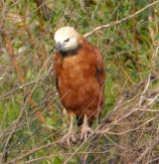
Another Black-collared Hawk

A pair of Greater Rhea

Toco Toucan

A pair of Toco Toucans posturing at each other

Wattled Jacanas have long toes that mean they can walk easily on water lilies

This Cattle Tyrant has taken over a Jacana’s lilly…

White-faced Whistling-Ducks and a Wattled Jacana

Large-billed Terns (left) and Black Skimmers (right) can be seen in both the Amazon and Pantanal

Black-collared Hawks are successful fishers

A family of Rhea walking wandering along the road in the Pantanal

Yellow-headed Caracara

One of our favourites – a Hyacinth Macaw

Blue-and-yellow Macaw

We saw a few Chestnut-eared Aracari in the Pantanal but this was the best photo we got!

Some Spoonbills

A pair of Souther Screamers

Horned Screamers are very large (and very noisy) birds, usually found in pairs…

…it is quite impressive how easily they take off

I was very keen to see some Hoatzin, a peculiar bird whose chicks have claws on their wings to stop them falling into the water. This photo was taken by Marilyn, one of the Earth Watch volunteers on our Amazonian trip

Anhinga

A Great Black Hawk looks down on us

A Turquoise-fronted Parrot

A pair of Hyacinth Macaws

Chestnut-fronted Macaws

A hawk startling a flock of parakeets…

…before they settled down…

…then we could see that they were Yellow-chevroned Parakeets

A Mealy Parrot?

Osprey are rare in the UK. They are quite common elsewhere, especially here in the Colombian wetlands of Mompox

Limpkin

Black-collared Hawk flying

Great Egrets settling down for the night
Galapagos

A Flightless Cormorant, found only in the west of the Galapagos
Finally, if you have the money (or have put it aside because you cannot really miss them out after training as a biologist), it is well worth visiting the Galapagos Islands. Galapagos is a special experiences and the only way to see endemic species such as the Flightless Cormorant.

Breeding season for frigate birds in the Galapagos

Lunchtime…

You have to smile at a Blue-footed Booby

Look at me, look at me…

A Swallow-tailed Gull

Sky full of frigate birds in the Galapagos

A handy resting spot

Juvenile Red-footed Boobys don’t have red feet! This one landed on the boat and couldn’t take off again so I picked it up and successfully launched it away from the boat

The Lava Gull is endemic to the Galapagos. This one is a juvenile

The Lava Heron is also endemic

Who has the best feet?

Brown Noddys

The Flightless Cormorant. I was particularly keen to see them as I did my PhD on European cormorants

Another Lava Heron

The Galapagos Hawk is not very easy to see so we were very lucky, especially as it had caught a Marine Iguana. The crabs in the background are Sally Lightfoot Crabs

This hawk was ringed, probably when it was a chick

A Galapagos Flycatcher, yet another endemic

There are plenty of Darwin’s Finches around, but the different species can be difficult to tell apart…

Some are quite tame

American Flamingo in the Galapagos. These got blown over form the Caribbean and cannot get back because of the prevailing winds

Delightful Wilson’s Storm-Petrels dance on the water. They are extremely common and widespread but I don’t think anyone knows where they breed
Playa Larga, Cuba

The national bird of Cuba – a Cuban Trogon
Our final birding session was on a trip to Cuba where we hired the local guide in Playa Larga at the top of the Bay of Pigs. He took us into the surrounding woods and pointed out many of the endemic birds, including the Cuban Pygmy Owl, the Cuban Tody and the national bird, the Cuban Trogon. At the end we asked him about the Bee Hummingbird (the smallest bird in the world) and he took us to a house where some turn up to feed on the feeders. There are only a few breeding pairs in the area and he is involved in surveying them every year.

Cuban Trogon displaying

Birding with Chino in Playa Larga

A Cuban Emerald

Cuban Pygmy Owl

Cuban Tody

Cuban Green Woodpecker

Red-legged Thrush

Killdeer

Cuban Emerald

Male Bee Hummingbird – the smallest bird in the world!

Female Bee Hummingbird
 There are so many places to see birds in South America, covering a wide variety of habitats and ecosystems. In the second part of our blog about our experiences of birding in South America, I will talk a bit about some of the places we visited. To make it a bit more cohesive, I have roughly grouped them into seven themes, each with its own accompanying gallery of some of our favourite photos.
There are so many places to see birds in South America, covering a wide variety of habitats and ecosystems. In the second part of our blog about our experiences of birding in South America, I will talk a bit about some of the places we visited. To make it a bit more cohesive, I have roughly grouped them into seven themes, each with its own accompanying gallery of some of our favourite photos.





 There are few environments that can beat cloud (or fog) forests for the sheer biodiversity of birds. They are found at altitudes around 500m – 3,000m in the Andes, generally in a tight band dependent on the local environmental conditions. The only problem is that they are also good places to find mosquitoes and black flies, whilst the foliage provides perfect camouflage for the birds. In fact the first place we went in northern Argentina (Parque Nacional Calilegua) was where we discovered the those downsides.
There are few environments that can beat cloud (or fog) forests for the sheer biodiversity of birds. They are found at altitudes around 500m – 3,000m in the Andes, generally in a tight band dependent on the local environmental conditions. The only problem is that they are also good places to find mosquitoes and black flies, whilst the foliage provides perfect camouflage for the birds. In fact the first place we went in northern Argentina (Parque Nacional Calilegua) was where we discovered the those downsides.


 The Pantanal is perfect for seeing wildlife because there is much less vegetation and when it is dry, the animals crowd round the available water sources (perfect for seeing Jaguars), whilst when it is wet, many animals are confined to the islands. We had a fantastic time driving in and out the Pantanal across many bridges (128 in 130km in the northern Pantanal). It is possible to see lots of wildlife from each one so you need to take your time driving around here! Lots of storks, herons and raptors to be seen, along with the beautiful Hyacinth Macaw and the Blue-and-yellow Macaw. We did manage to see birds in the Amazon, whilst on a great conservation cruise in the Pacaya-Samiria Reserve, Peru, but it was much more difficult to spot them and they were even harder to photograph. This is the largest of the galleries!
The Pantanal is perfect for seeing wildlife because there is much less vegetation and when it is dry, the animals crowd round the available water sources (perfect for seeing Jaguars), whilst when it is wet, many animals are confined to the islands. We had a fantastic time driving in and out the Pantanal across many bridges (128 in 130km in the northern Pantanal). It is possible to see lots of wildlife from each one so you need to take your time driving around here! Lots of storks, herons and raptors to be seen, along with the beautiful Hyacinth Macaw and the Blue-and-yellow Macaw. We did manage to see birds in the Amazon, whilst on a great conservation cruise in the Pacaya-Samiria Reserve, Peru, but it was much more difficult to spot them and they were even harder to photograph. This is the largest of the galleries!




















































































































































































































































































Pingback: Birding from the Yellow Van I: An overview by two complete amateurs | Yellow Van Days